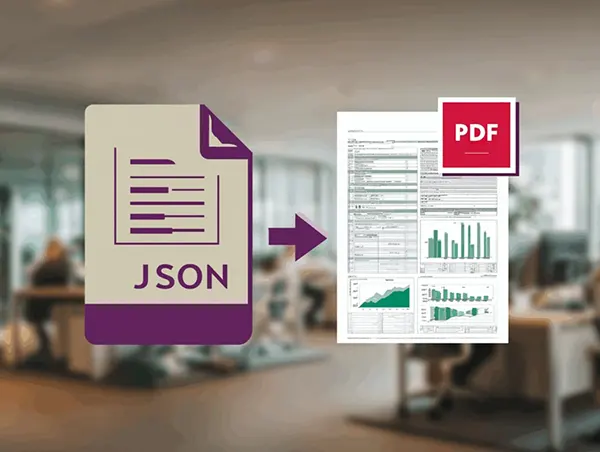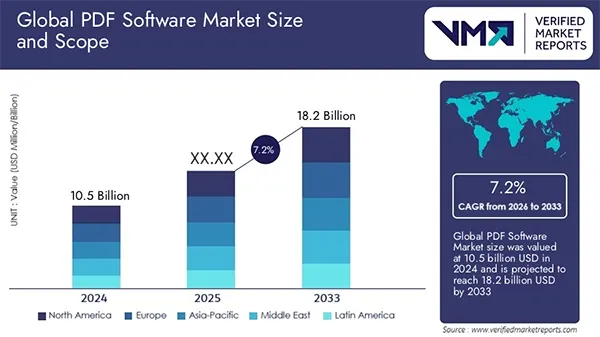KEY TAKEAWAYS
- Understand JSON format and data interchange requirements
- Learn how to professionally transform JSON into PDF
- Discover best practices for structured document creation
JSON stands for JavaScript Object Notation. It is a lightweight data interchange format. It is widely used to store and exchange data between web servers and clients.
JSON files are made for machines, and they are often messy and full of symbols, which is why it is necessary to convert them into a simple file, like a PDF, to make them readable for humans.
There are many tools available in the market that can help change a file from json to pdf. In this guide, you will learn how you can convert a JSON file to PDF documents for professional reporting.

JSON was originally developed for JavaScript, but it can be used in any language, and it is very popular in web applications. The basic structure is made from one or more key values.
JSON has come to be one of the most famous standards for data interchange, while being lightweight to provide small transmission sizes.
Let’s look at some key characteristics of JSON format for professional applications:
Data Structure: JSON represents data as key-value pairs, identical to dictionaries in Python, or objects in JavaScript. Data is organized into objects and arrays.
Data Types: JSON supports many data types, including strings, numbers, booleans, objects, arrays, and null.
Lightweight and compact: JSON format is concise, minimizing the data transmitted. This characteristic is important for bandwidth usage and improving performance.
Language and Platform Independence: JSON is a text-based format, making it universally compatible across various programming languages and platforms.
Professional JSON to PDF transformation uses programming libraries, APIs, and templating to automate the process, allowing for custom formatting, data preservation, and batch processes.
Key professional approaches include using SDKs, for example, Adobe SDK PDF, and document dynamic APIs for programming control, leveraging cloud-based platforms, with advanced templating or building custom solutions with Python and web frameworks to meet specific requirements.
DID YOU KNOW
PDF Software Market size stood at USD 10.5 Billion in 2024 and is forecast to achieve USD 18.2 Billion by 2033, registering a 7.2% CAGR from 2026 to 2033.

Conversion strategies accommodate different organizational needs and technical infrastructure requirements. Here are two main strategies:
A JSON PDF viewer is an application or a library that allows a viewer to view JSON data in a visually formatted PDF file. There are many online converters, open source tools, and libraries that allow this functionality so that non-developers can analyze JSON data.
Business branding guidelines ensure consistent corporate identity presentation. Company logo, color schemes, and typography must appear consistent. Create reusable templates, including all branding elements properly.
Here is how you can do that:
By doing this and understanding the JSON specification, you can fulfill enterprise data visualization requirements.
If you want to get professional results, it is important to focus on technical details. You can do that by doing some reliable practices like data validation and sanitization, and performance optimization. Now, to generate documents from JSON, you have to follow some steps.
Implementation steps for professional JSON-PDF conversion:
The W3C Data Exchange specifications provide guidance in the entire data transformation process.
Best practices for structured document creation, particularly when converting JSON to PDF, involve ensuring data integrity, maintaining formatting, and optimizing for scalability and automation.
Optimization strategies for professional JSON-PDF conversion workflows:
Template Standardization: Use a template to define the structure and branding of your PDF reports.
Automated Process Schedule: Automated process schedule and tools offer better control, accurate results without manual intervention, and save a lot of time.
Quality Assurance Protocol: Comprehensive validation procedures ensure data accuracy and formatting.
Integration Capabilities: Integrate seamlessly with existing systems and workflows, such as via API call.
Converting a JSON file into PDF is a very important process for companies, analytics, and developers, who have to present structured information in a professional format.
By now, you must have understood how you can convert a JSON file into a PDF. Although there are various methods in which this process can be done, you can choose the one according to your requirements, like simplicity, security, or batch processing.
AI like workik AI can read and work with JSON files.
You can open and read it in a standard text editor that comes with most Windows versions.
A JSON file is neither a file nor code; it is a simple format used to store and transport data.
The ‘json_decode() function’ is used to decode or convert a JSON object to a PHP object
